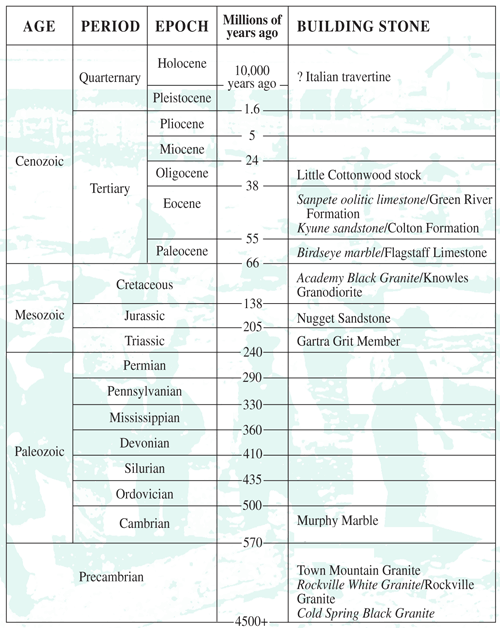Building Stones of Downtown Salt Lake City
A Walking Tour
This walking tour begins at the Utah State Capitol and finishes at the Salt Lake City and County Building, seven blocks to the south. On this tour, you will see building stones ranging in age between the 2.5 billion-year-old, Precambrian-age Cold Spring Black Granite to the geologically young, Quaternary-age travertine.
Building stone is rock that is used in the construction of buildings, retaining walls, bridges, and other structures and includes building components such as walls, foundations, sills, chimneys, and steps. The most desirable building stones have a combination of strength; durability; beauty; and ease of quarrying, cutting, and carving. Varieties of all three rock types – sedimentary, igneous, and metamorphic – are used as building stones.

On this tour, you will see building stones ranging in age between the 2.5 billion-year-old, Precambrian-age Cold Spring Black Granite to the geologically young, Quaternary-age travertine.
What is Building Stone?
Well, as you might have guessed, building stone is rock that is used in the construction of buildings, retaining walls, bridges, and other structures and includes building components such as walls, foundations, sills, chimneys, and steps.
The most desirable building stones have a combination of strength; durability; beauty; and ease of quarrying, cutting, and carving.
What Kinds of Stones are Used?
Varieties of all three rock types – sedimentary, igneous, and metamorphic – are used as building stones.
Sedimentary rocks are extremely varied, differing in color, texture, and composition. Some like sandstone are composed of sediments eroded from previously existing rocks, while others such as limestone are composed of sediments precipitated from dissolved materials. These sediments are deposited in layers which, over time (a very long time), are compacted and cemented together.
- Travertine and other compact varieties of limestone are classified as marble (see metamorphic rocks) by the building stone industry. In Utah, sandstone and limestone have been quarried since pioneer days and are the most frequently used sedimentary building stones.
Igneous rocks are formed from magmas, which are molten mixtures of minerals found deep below the earth’s surface. Some igneous rocks cool and harden deep underground (granite, quartz monzonite, and diorite) and may later be exposed by erosion, whereas others reach the surface as basaltic lava flows and other volcanic deposits (such as rhyolite).
- Due to its strength, durability, and capability of being quarried in large massive blocks, granite has historically been used for imposing government and religious structures. Lava with interesting textures and rhyolite with intricate color banding are frequently used as building veneers.
Metamorphic rocks formed from pre-existing rocks that were altered by high heat, pressure, and/or the chemical actions of fluids and gases. Some common metamorphic building stones are quartzite (altered sandstone), marble (altered limestone), slate (altered shale), and granitic gneiss (altered granite; gneiss is pronounced “nice”).
What Building Stones Will I See On My Tour?
| Sedimentary Building Stones (Trade name in italics; stone quarried in Utah unless indicated otherwise; year of construction follows building name) |
|
|---|---|
Sandstone: |
|
Nugget Sandstone
|
Kyune sandstone/Colton Formation
|
Limestone: |
|
Sanpete oolitic limestone/Green River Formation
|
Birdseye marble/Flagstaff limestone
|
| Igneous Building Stones | |
Granite: |
|
Town Mountain Granite (Texas)
|
Rockville White Granite/Rockville Granite (Minnesota)
|
Diorite: |
|
Academy Black Granite/Knowles Granodiorite (California)
|
|
Quartz Monzonite: |
|
Little Cottonwood stock
|
|
| Metamorphic Building Stones | |
Quartzite: |
|
Gartra Grit Member of Ankareh Formation
|
|
Marble: |
|
Murphy Marble (Georgia)
|
|
*Church of Jesus Christ of Latter-day Saints


